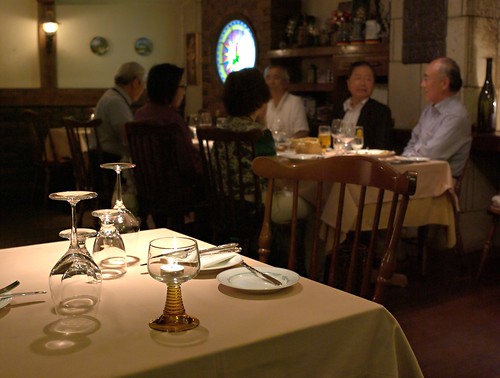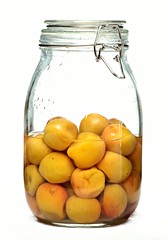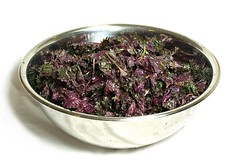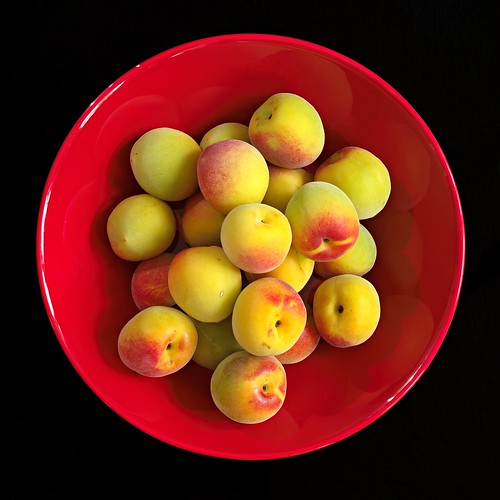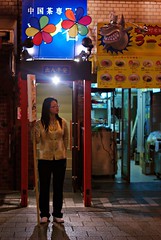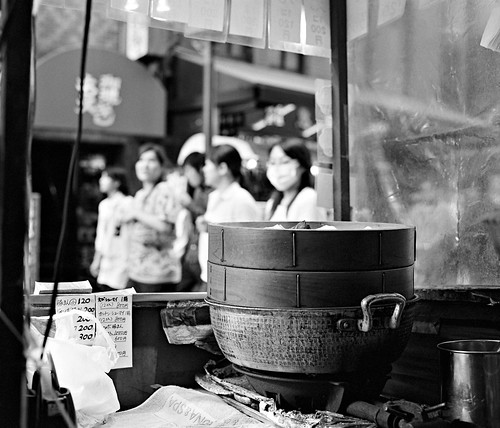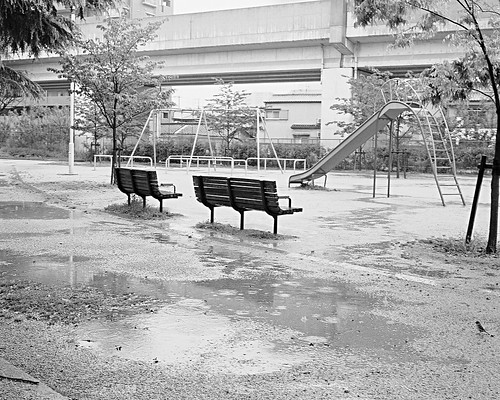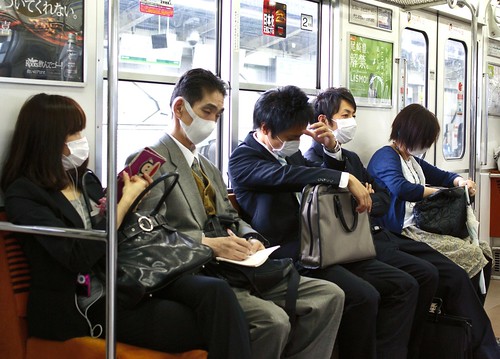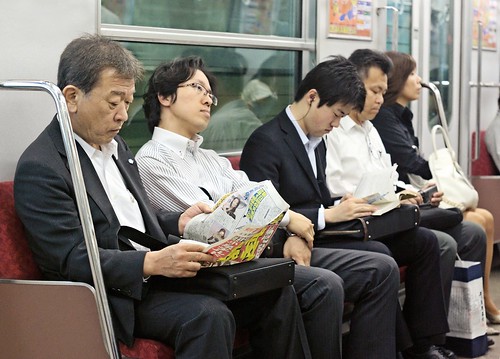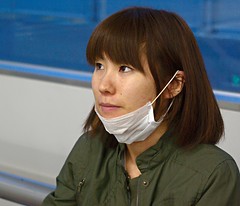I turned forty today. My beard is visibly graying. My next pair of glasses will be bifocals. The top of my head has better use for sunscreen than for a comb. I am officially no longer "young" or "promising" for anything. Any year now, I may have to decide what I want to do when I grow up.
On the other hand, at 40 half my life still lies ahead of me - two-thirds, if you count just your adult life. That's statistically speaking of course; I could live to a hundred, or I could get run over by a bus tomorrow. Thirty, forty years of adulthood is a long time. It takes less than ten years to go from novice to proficient in most fields; in forty years you could have another two full careers.
The 40th birthday seems to create a lot of anxiety in many people; I don't really see why. Much worse, for me, was 25. That's when you're irrevocably an adult with adult responsibilities and expectations piling up. That's when you're expected to "go out in the world", "make your mark", "be all that you can be" and so on. You're supposed to build your career, start a family, become famous, become rich, seize the day...
"Be all that you can be" - well, by 40 you know what "you can be". You know what you'll be able to achieve and what you will not. Nobody expects you to do more than muddle through life, experience piling up and body gently falling apart. Which is great. With the pressure to succeed gone you're free to make you and your family happy instead. Do things because they're interesting, not because they benefit your career or your social status. And if you do decide to embark on something new you can do it quietly, with little fuss, and without expectations weighing you down.
No, 40 is not a problem. If anything this is the best time of my life so far. I have an interesting (if temporary) project to work on, fun hobbies, friends and acquaintances dotted around the world, and I'm happily married to a woman I love to distraction. I may finally be getting the hang of this whole "life" thing. I'll take 40 over 25 anytime.
Anyway, on our birthdays we always treat each other to dinner, preferably somewhere we would not normally go. Somewhere too expensive, too far away or too special for us to go on a normal weekend. On my birthday last year we had Kobe steak, and on Ritsuko's birthday we had traditional French cuisine. This year we ate dinner at "Rote Rose", a German restaurant and wine importer in Kobe.
The menu is very German, of course, with a fairly extensive wine list but only one beer (Löwenbräu). Ritsuko had today's fish and I had eisbein with sauerkraut. It was very good; the meat was savoury and very tender and the fat was not runny or bland. I have to say, though, that I'm no longer used to this kind of food; it was all I could do to finish the plate. Good food overall, if perhaps a bit overpriced. Not a restaurant for a beer lover but if you like German wines this seems a very good place to go.
Saturday, June 27, 2009
Friday, June 26, 2009
Campaign Money - the Neverending Story
Japan's Finance minister Yosano seems to have been accepting donations from a dummy front set up to pay politicians for more than twenty years. He may possibly have acted illegally in accepting the money, though my guess is he didn't. Maybe he knew the source was dubious, but probably he did not. It hardly matters.
The elections are a couple of months away and as finance minister he's one of the most high-profile members of the cabinet. This is not a good time for the Aso government to remind everyone of the low-grade sleaze and shady deals that has become a hallmark of the LDP era. It's perhaps especially inconvenient that it's the minister of finance, who is supposed to be the man of the hour in this economic crisis. A bit difficult to send him out to calm the electorate if the journalists keep bringing up suspect campaign donations.
Also of note: The monthly Japan blog matsuri is up, with the theme of Living on a budget in Japan. Plenty of good entries there.
The elections are a couple of months away and as finance minister he's one of the most high-profile members of the cabinet. This is not a good time for the Aso government to remind everyone of the low-grade sleaze and shady deals that has become a hallmark of the LDP era. It's perhaps especially inconvenient that it's the minister of finance, who is supposed to be the man of the hour in this economic crisis. A bit difficult to send him out to calm the electorate if the journalists keep bringing up suspect campaign donations.
Also of note: The monthly Japan blog matsuri is up, with the theme of Living on a budget in Japan. Plenty of good entries there.
Wednesday, June 24, 2009
Umeboshi
We're making umeboshi this year in addition to the umeshū I wrote about earlier. Umeboshi are sour pickled Japanese plums; chewy but soft, sour but savoury. They're very popular and you can find multiple brands in any store. You eat them as a topping on rice, as an onigiri filling, or just straight up. A favourite of mine is to chop up one or two umeboshi, mix the pulp with a bit of soy sauce and use the resulting paste as a flavouring or dip for gyouza.
The process is a little more involved than making umeshū. The name means "dried plums", and drying them is one step along the way. What we'll do first is to pickle the plums in brine for a month or so. Then we'll sun-dry them for a few days and finally return them into the brine again. This creates the soft chewiness and very thick, succulent, savoury taste that is the hallmark of good umeboshi. There's several varieties including plain, shiso-leaf flavoured (it gives them a characteristic taste and strong red colour), and honey-flavoured. We're making all of those this year.
The basic recipe is 1kg plums, 150g salt1 and a little bit of clear distilled alcohol (white liquor, vodka or something like that). Clean the plums well, then soak them in water for a few hours. Meanwhile, use some of the alcohol to carefully rinse the glass jar and lid. One of the few problems that can crop up is mold and we want to prevent that if possible.
If you're making umeboshi with shiso, the shiso leaves go in after 3-10 days, depending on the recipe - basically, you can add it at any time after the ume is covered in the brine. You can get prepared leaves if you want, or buy a bagful of fresh ones. The preparation is really easy: Take a big bowl of leaves, sprinkle about two tablespoons of salt over them, and start rubbing the salt into the leaves with your hands. They'll soften, shrink and release a lot of red liquid almost immediately. After a couple of minutes that big heap is reduced to red water and a lump of soggy leaves. Add the lump of leaves to the jar.
This is as far as we'll get for now. The ume are quietly pickling in their sour, salty brine for the next six weeks or so. We'll take the next step around the Obon holiday in early August and dry the plums in the strong summer sun.
--
The process is a little more involved than making umeshū. The name means "dried plums", and drying them is one step along the way. What we'll do first is to pickle the plums in brine for a month or so. Then we'll sun-dry them for a few days and finally return them into the brine again. This creates the soft chewiness and very thick, succulent, savoury taste that is the hallmark of good umeboshi. There's several varieties including plain, shiso-leaf flavoured (it gives them a characteristic taste and strong red colour), and honey-flavoured. We're making all of those this year.
The basic recipe is 1kg plums, 150g salt1 and a little bit of clear distilled alcohol (white liquor, vodka or something like that). Clean the plums well, then soak them in water for a few hours. Meanwhile, use some of the alcohol to carefully rinse the glass jar and lid. One of the few problems that can crop up is mold and we want to prevent that if possible.
When the plums are done soaking, put them in the jar. Ideally there should be just enough to completely fill up the jar. Be careful that you don't damage the skin of the fruit. Add the salt, then pour about 50cc of the alcohol over the salt so it partially dissolves and dribbles down through the jar. Don't worry if there's salt left at the top. You can interleave the fruit with the salt if you want but it's not necessary. Many people use weights to press the plums down but it's not needed - the ume are heavy enough to sink on their own - so we don't bother with it.
Now we wait. The salt will start drawing out liquid from the plums, and pretty soon there'll be a pool of brine at the bottom. In time the liquid level rises and the plums shrink. You can carefully turn the jar over about twice a day for the first couple of days if you want to make sure the salt dissolves and all the plums get soaked in the liquid. Be careful that you don't damage them, though; they're getting pretty soft. After three days or so the fruit should be completely submerged.
Now we wait. The salt will start drawing out liquid from the plums, and pretty soon there'll be a pool of brine at the bottom. In time the liquid level rises and the plums shrink. You can carefully turn the jar over about twice a day for the first couple of days if you want to make sure the salt dissolves and all the plums get soaked in the liquid. Be careful that you don't damage them, though; they're getting pretty soft. After three days or so the fruit should be completely submerged.
If you're making umeboshi with shiso, the shiso leaves go in after 3-10 days, depending on the recipe - basically, you can add it at any time after the ume is covered in the brine. You can get prepared leaves if you want, or buy a bagful of fresh ones. The preparation is really easy: Take a big bowl of leaves, sprinkle about two tablespoons of salt over them, and start rubbing the salt into the leaves with your hands. They'll soften, shrink and release a lot of red liquid almost immediately. After a couple of minutes that big heap is reduced to red water and a lump of soggy leaves. Add the lump of leaves to the jar.
This is as far as we'll get for now. The ume are quietly pickling in their sour, salty brine for the next six weeks or so. We'll take the next step around the Obon holiday in early August and dry the plums in the strong summer sun.
--
#1 Recipes are typically 12-18% salt by weight. That's a lot of salt. Most of it ends up in the brine, not the plums though, and you don't eat more than one or two plums at one time so it's OK. Don't skimp on the salt; it prevents mould.
Monday, June 22, 2009
Zotero Lawsuit
A bit late on this: I wrote a good long while ago about Zotero, an open source reference management tool, and how Thomson Reuters, makers of EndNote, the most widely used (or at least most heavily advertised) such tool was suing GMU, where Zotero is developed, in court. Their grievance was that Zotero included a filter to convert citation format definitions from the EndNote file format and they claimed this was a copyright violation. This was a preposterous lawsuit, made even more so as these format definition files weren't even created by Thomson Reuters at all but by their users.
This lawsuit finally reached the court a couple of weeks ago, and the court promptly threw the whole thing out.
I use Zotero myself nowadays, and while it's far from perfect (the user interface is rather frustrating on a small screen), it is certainly good enough for real-world use. If you need a citation manager I advice you to take a good look at Zotero or other alternatives before locking your own citation and bibliography data up in EndNote. Thomson Reuters have after all shown that they're willing to go to court to prevent you from leaving them once they got you.
This lawsuit finally reached the court a couple of weeks ago, and the court promptly threw the whole thing out.
I use Zotero myself nowadays, and while it's far from perfect (the user interface is rather frustrating on a small screen), it is certainly good enough for real-world use. If you need a citation manager I advice you to take a good look at Zotero or other alternatives before locking your own citation and bibliography data up in EndNote. Thomson Reuters have after all shown that they're willing to go to court to prevent you from leaving them once they got you.
Friday, June 19, 2009
Midsummer
Today is Midsummer in Sweden. The actual summer solstice is on Sunday, but the celebration is on the Friday closest to the solstice. It's for practical reasons - nobody wants to have to go to work the next day if they can at all avoid it. No celebration for us here in Osaka - just as well; I'm still embarrassed from getting far too drunk last year - but we did have a vaguely north-European dinner tonight, with German sausages, smoked salmon, goat-cheese toast and mashed potatoes with dill.
Happy Midsummer, wherever you are!
Happy Midsummer, wherever you are!
Umeshu
'Tis plum season and time for umeshū again, the sweet, savoury Japanese plum liquor. It's getting more and more popular in summer - sales are twice what they were ten years ago - and for good reason. It goes well chilled or on ice, and even better with a drop of lemon juice or mixed with apple cider (my favourite). Best of all, it's really easy and cheap1 to make your own.
Ume, Japanese plums. These are sour and hard and nothing you'd want eat. Great for making a drink from.
There's nothing to it: put some sour plums in a large jar together with rock sugar and "white liquor" - flavourless alcohol, usually about 30-35%. Recipes typically call for around 1kg plums, 2l alcohol and 400-600g sugar. Wait six months2 to a year, then drink. The plums themselves become soft and really savoury and make an excellent jam if you wait no longer than a year to take them out. If you start a jar now, you'll have your first taste right around New Year.
All you need: ume, rock sugar, some inexpensive alcohol (the good stuff is wasted on this) and a jar for it all. Mix. Wait. Drink.
Last year we made vodka-based and rum-based umeshū, just to see what'd it be like. A year later we can say that they're both good, though a little tart for our taste; we ended up adding a bit of sugar to them over the winter. We used the cheapest white rum we could find, and that may have been a mistake, as the rum flavours have almost disappeared. A dark rum may be more interesting.
--
Ume, Japanese plums. These are sour and hard and nothing you'd want eat. Great for making a drink from.
There's nothing to it: put some sour plums in a large jar together with rock sugar and "white liquor" - flavourless alcohol, usually about 30-35%. Recipes typically call for around 1kg plums, 2l alcohol and 400-600g sugar. Wait six months2 to a year, then drink. The plums themselves become soft and really savoury and make an excellent jam if you wait no longer than a year to take them out. If you start a jar now, you'll have your first taste right around New Year.
All you need: ume, rock sugar, some inexpensive alcohol (the good stuff is wasted on this) and a jar for it all. Mix. Wait. Drink.
Last year we made vodka-based and rum-based umeshū, just to see what'd it be like. A year later we can say that they're both good, though a little tart for our taste; we ended up adding a bit of sugar to them over the winter. We used the cheapest white rum we could find, and that may have been a mistake, as the rum flavours have almost disappeared. A dark rum may be more interesting.
So this year we're doing another experiment, and making a brandy-based version. Our recipe is very simple: 1kg green plums, 400g sugar and two bottles of cheap brandy. Unlike umeboshi that needs high-quality fruit, you can use tart, damaged and scarred plums for this. No need to waste money on the expensive stuff.
Clean the plums (wash them and remove the stem ends with a toothpick). Spend an hour taking a picture of all the ingredients while your wife patiently waits. Put them in a jar with the sugar and pour over the alcohol. Spend another two hours trying to take a decent shot of the jar without having it look too much like a specimen in a disreputable medical museum. put the jar in the closet for the next six months and call it a day. See, not difficult at all.
Ps. This is my entry to this month's Blog Matsuri and the theme is living on a budget in Japan3. ds.
Clean the plums (wash them and remove the stem ends with a toothpick). Spend an hour taking a picture of all the ingredients while your wife patiently waits. Put them in a jar with the sugar and pour over the alcohol. Spend another two hours trying to take a decent shot of the jar without having it look too much like a specimen in a disreputable medical museum. put the jar in the closet for the next six months and call it a day. See, not difficult at all.
Ps. This is my entry to this month's Blog Matsuri and the theme is living on a budget in Japan3. ds.
--
#1 OK, so cardboard-box umeshū is a bit cheaper, but that's not even made with whole plums, and we do get a whole jar of ume jam out of this too. If you compare with good-quality stuff, you do save some money making it yourself. If you have a local source of plums, or your own tree, it's really no contest. Besides, cheaper or not, making it yourself is more fun!
#2 It's drinkable after three months, but it really needs at least half a year to develop the flavour.
#3 Not budgety enough? Here's an easy tip: Don't shop. The shopping culture here is hysterical; there's a ridiculous amount of shops around. Half the country states shopping is their main hobby. This is frankly one of the less attractive aspects of this place - on beautiful, temperate spring weekends you'll find the beaches and riverbanks half deserted but the malls crammed with crowds.
If you want to save, don't get sucked in. You don't need those clothes or that eggtimer or DVD player or a box of Pocky or a new phone or a new strap for the phone or cleaning liquid for the strap or a sailor outfit for your dog or a designer bag in which to carry it all; you want it. There's a difference. Buy what you need, not what you want4 and you'll be surprised how much money you save.
If you want to save, don't get sucked in. You don't need those clothes or that eggtimer or DVD player or a box of Pocky or a new phone or a new strap for the phone or cleaning liquid for the strap or a sailor outfit for your dog or a designer bag in which to carry it all; you want it. There's a difference. Buy what you need, not what you want4 and you'll be surprised how much money you save.
Wednesday, June 17, 2009
When Danger Strikes!
Nara has its first swine flu infection, and an email has gone out to everybody at my work with information and advice. Sensible enough. They send it out in Japanese as well as English, which is very appreciated by us non-Japanese. I just wish they had somebody do a quick check that the translation is hitting the right tone.
The passage I reacted to reads, in Japanese:
Approximately translated as:
The English email, however, said:
Which, frankly, is rather more panic-inducing that I believe the authors may have intended. To me "being alarmed" is appropriate when, say, Godzilla has eaten the lunch cafeteria and is approaching our building for dessert.
On the other hand, I'd not have read it with such rapt attention had the word "alarmed" not jumped out at me from the text.
The passage I reacted to reads, in Japanese:
各位におかれましては、引き続き、下記の点にご留意いただき、適切な対応をお願いいたします。
Approximately translated as:
Everybody, please remember to take heed of the following points and take appropriate precautions.
The English email, however, said:
The University urges all the members to be alarmed about the following points and must respond to this matter with serious attention.
Which, frankly, is rather more panic-inducing that I believe the authors may have intended. To me "being alarmed" is appropriate when, say, Godzilla has eaten the lunch cafeteria and is approaching our building for dessert.
On the other hand, I'd not have read it with such rapt attention had the word "alarmed" not jumped out at me from the text.
Tuesday, June 16, 2009
Poll Time!
It seems Prime Minister Aso is back to working on his single digit approval ratings again now that former opposition party leader Osawa is gone. The DPJ elected Hatoyama as party leader, and Prime minister Aso finally kicked out interior minister Hatoyama1 after Aso passively let an interministerial power struggle fester in public for the past week. Clearly time for a poll, in other words, and the major news networks have obliged.
Aso gets all of 15% personal approval in a Mainichi News poll which probably translates to the low 20's in non-partisan terms (Mainichi is not a great fan of the LDP). In a similar Kyodo News poll, Aso gets about 20%. Support for the Aso government is stated to be 19% and 17% respectively - call it 20%:2. Even the LDP-friendly Yomiuri poll (which didn't ask for, or doesn't disclose, Aso approval figures) found only a bit over 20% support for the cabinet. Not a level most politicians would be comfortable with, less than three months before an election.
It is worth pointing out that Hatoyama (the elder brother, the new DPJ leader) gets about 30% support in the Mainichi poll, which is much better than Aso's figure but he is still beat by Mr. None Of The Above at around 45%. The Yomiuri poll seems to have asked people to specifically pick between Hatoyama and Aso and found Hatoyama lead with 45% over 25%; no word on what the remaining answers where Hatoyama got over 50% in the Kyodo poll, which leads me to suspect their question was similar to Yomiuri's, and perennial favourite None Of The Above was not an option3. The DPJ gets about 40% versus LDP's 20% in the Kyodo poll, 35% and 20% in the Mainichi poll, and 30% versus 25% in Yomiuri. Again, the party of None Of The Above seems to be at least as popular as the DPJ.
In other words, DPJ is not tearing up the boards here. It's popularity rests simply on the virtue of not being the LDP. If it manages to win the next election, I expect a brief and unenthusiastic honeymoon with the electorate ending in the inevitable Narita Rikon4 once the voters realize their new partner is no different from their previous one.
--
Aso gets all of 15% personal approval in a Mainichi News poll which probably translates to the low 20's in non-partisan terms (Mainichi is not a great fan of the LDP). In a similar Kyodo News poll, Aso gets about 20%. Support for the Aso government is stated to be 19% and 17% respectively - call it 20%:2. Even the LDP-friendly Yomiuri poll (which didn't ask for, or doesn't disclose, Aso approval figures) found only a bit over 20% support for the cabinet. Not a level most politicians would be comfortable with, less than three months before an election.
It is worth pointing out that Hatoyama (the elder brother, the new DPJ leader) gets about 30% support in the Mainichi poll, which is much better than Aso's figure but he is still beat by Mr. None Of The Above at around 45%. The Yomiuri poll seems to have asked people to specifically pick between Hatoyama and Aso and found Hatoyama lead with 45% over 25%; no word on what the remaining answers where Hatoyama got over 50% in the Kyodo poll, which leads me to suspect their question was similar to Yomiuri's, and perennial favourite None Of The Above was not an option3. The DPJ gets about 40% versus LDP's 20% in the Kyodo poll, 35% and 20% in the Mainichi poll, and 30% versus 25% in Yomiuri. Again, the party of None Of The Above seems to be at least as popular as the DPJ.
In other words, DPJ is not tearing up the boards here. It's popularity rests simply on the virtue of not being the LDP. If it manages to win the next election, I expect a brief and unenthusiastic honeymoon with the electorate ending in the inevitable Narita Rikon4 once the voters realize their new partner is no different from their previous one.
--
#1 A different Hatoyama - yes, they're brothers, and yes, I'm happy there isn't a third Hatoyama brother around in Japanese politics; it's all too similar to a Korean soap-opera already.
#2 Giving two- or three-digit precision for polls like these is pointless and actively misleading. Polls of this magnitude, and especially with a skewed, partially self-selected sample (only about 2/3 answered the questions), rarely have better precision than 4-5 percentage points or so.
#3 This is the main problem with these kind of poll articles: they don't give you the methodology, the error estimates (which vary from question to question) or the actual questions asked. It makes them impossible to compare with each other, or even to estimate the true change over time for the same poll.
#4 Narita Rikon - Narita Divorce - is when a couple gets married without first getting to know each other, discover on their honeymoon that they actually dislike each other, and immediately file for divorce on return to Narita airport.
Monday, June 15, 2009
Mail Fraud Arrests
A brief1 followup to my earlier posts about the large-scale mail fraud case that's been uncovered this spring: The fake disability group set up to make use of discounted mail rates needed certification from the ministry of health, labour and welfare. They got this certification from a director-general at the ministry in 2004, and said director-general has now been arrested and both the ministry offices and home searched.
As MTC points out so eloquently, you do not arrest high-ranking officials and search the ministry unless you have a fairly solid case. Or if the prosecutors really have jumped the gun the backlash couldn't happen to a nicer bunch of people. The lawmaker that leaned on the ministry to certify the organization is as yet unnamed, but one of the two parties is going to have a nice little scandal to throw into the election campaign in a couple of months, depending on which party the offending diet member belongs to. Amazingly, it's actually not illegal for politicians to interfere directly in individual cases here, but the fallout should be plenty effective anyway. Wouldn't it be interesting if it turned out to be, say, a senior New Komeito member...
--
As MTC points out so eloquently, you do not arrest high-ranking officials and search the ministry unless you have a fairly solid case. Or if the prosecutors really have jumped the gun the backlash couldn't happen to a nicer bunch of people. The lawmaker that leaned on the ministry to certify the organization is as yet unnamed, but one of the two parties is going to have a nice little scandal to throw into the election campaign in a couple of months, depending on which party the offending diet member belongs to. Amazingly, it's actually not illegal for politicians to interfere directly in individual cases here, but the fallout should be plenty effective anyway. Wouldn't it be interesting if it turned out to be, say, a senior New Komeito member...
--
#1 I'm writing up something for work right now, which makes writing for the blog less than ideal as a diversion. Don't expect long, windong posts for the next week or so.
Friday, June 12, 2009
Chinatown
Nankinmachi is the Chinatown in Kobe. Long ago the area housed Chinese merchants come to Japan to trade, just like the European merchants clustered in their mansions up towards the mountainside. Those European villas are now Western-style restaurants and wedding chapels, and similarly, Nankinmachi is now home to a busy Chinese-themed shopping and restaurant area. It's not very big (nothing like its counterpart in Yokohama) but there's still plenty of restaurants, ramen joints, street stalls, food speciality stores and the inevitable piles of souvenirs and other trinkets. The area is normally packed, with long lines for the most popular places.
Street stall selling butaman (steamed pork buns) to hungry passers-by. Way, way better than the butaman sold at convenience stores during winter.
While there's still a lot fewer people around than usual it's clear we weren't the only ones with that idea in mind. The lines were back for the most popular ramen and butaman joints, and while we didn't have to wait, the restaurant we picked was seating almost every table. If you have similar plans it's probably a good idea to go soon; at this rate the area will be back to its normal crowded self within a few more weeks.
Nankinmachi is a touristy place, and we've kind of avoided eating there because of the crowds and a perception of high prices and indifferent food. That perception turned out, at least in our case, to be completely false. We ate at a restaurant right on the square called Toeishuke, and it was delicious (the chicken in lemon sauce could have used a bit more bite, but the rest was great). The dishes were large, with three dishes plenty for two people, and the whole meal was surprisingly inexpensive. We're certain to go back again, and soon. The whole set of pictures are available here.
However, for the past month or so Kobe has been the unwitting host to the Japanese swine flu outbreak. Kobe lost a lot of visitors and Nankinmachi was all but deserted as tours, school excursions and business travelers all canceled or postponed their visits. A number of businesses simply closed for a week or more. Some places take the opportunity to clean up or renovate; one restaurant has apparently taken the entire staff on a job-training and education trip.
But now the uncertainty and hysteria is passing and people are finding their way back. Two weeks ago there was still few people about and our favourite Indian restaurant had far fewer customers than usual but at least shops and restaurants were mostly open again and few people bothered with masks any longer. We realized, then, that we had a golden opportunity to go eat dinner in Nankinmachi without having to stand in line and jostle the crowds. Said and done, we went back to Kobe again the last weekend, to eat Chinese rather than Indian for once.
But now the uncertainty and hysteria is passing and people are finding their way back. Two weeks ago there was still few people about and our favourite Indian restaurant had far fewer customers than usual but at least shops and restaurants were mostly open again and few people bothered with masks any longer. We realized, then, that we had a golden opportunity to go eat dinner in Nankinmachi without having to stand in line and jostle the crowds. Said and done, we went back to Kobe again the last weekend, to eat Chinese rather than Indian for once.
Street stall selling butaman (steamed pork buns) to hungry passers-by. Way, way better than the butaman sold at convenience stores during winter.
While there's still a lot fewer people around than usual it's clear we weren't the only ones with that idea in mind. The lines were back for the most popular ramen and butaman joints, and while we didn't have to wait, the restaurant we picked was seating almost every table. If you have similar plans it's probably a good idea to go soon; at this rate the area will be back to its normal crowded self within a few more weeks.
Nankinmachi is a touristy place, and we've kind of avoided eating there because of the crowds and a perception of high prices and indifferent food. That perception turned out, at least in our case, to be completely false. We ate at a restaurant right on the square called Toeishuke, and it was delicious (the chicken in lemon sauce could have used a bit more bite, but the rest was great). The dishes were large, with three dishes plenty for two people, and the whole meal was surprisingly inexpensive. We're certain to go back again, and soon. The whole set of pictures are available here.
Wednesday, June 10, 2009
Tsyu Days Are Here Again
Tsuyu - the summer rainy season - has been declared by the meteorological agency; looking out the window at the dripping wet world outside it's not exactly a major surprise. This is a mixed blessing. On one hand, it does keep the temperature down, with highs normally below 30° even on sunny days. On the other hand, it's wet. Everything is wet. Rainy days are worst, of course, and there's a lot of them right now. Osaka gets over 200mm of rain in June; not a huge amount by south Asian standards, but by comparison Stockholm gets less than 70mm during its wettest month of August.
Rainy day, Nishitanabe, Osaka. Not a great picture, but I'm in no mood to go out and take a better one - it's wet and miserable out there.
It's not the water, though, it's the humidity that gets to you. Everything gets damp. During cool nights you end up feeling clammy and miserable - you're hot and freezing at the same time. Mildew and fungus thrive in this weather (real fun cleaning the bath this time of year), and food poisoning becomes a real risk so you have to be careful with your produce and ingredients.
On the other hand, it's plum season. Now is the time to buy (or pick, if you have a tree) the barely ripe green plums and pickle in brine for umeboshi, or put in jars of alcohol for umeshu. We'll try to make hachimitsu (honey) umeboshi this year in addition to the normal stuff. The vodka and rum umeshu we made last year are so-so; the vodka is good but needs a bit more time to ripen. We probably should have used better quality rum, as that variety has very little actual rum flavour left. This year we'll try to make brandy umeshu and see how that goes.
Rainy day, Nishitanabe, Osaka. Not a great picture, but I'm in no mood to go out and take a better one - it's wet and miserable out there.
It's not the water, though, it's the humidity that gets to you. Everything gets damp. During cool nights you end up feeling clammy and miserable - you're hot and freezing at the same time. Mildew and fungus thrive in this weather (real fun cleaning the bath this time of year), and food poisoning becomes a real risk so you have to be careful with your produce and ingredients.
On the other hand, it's plum season. Now is the time to buy (or pick, if you have a tree) the barely ripe green plums and pickle in brine for umeboshi, or put in jars of alcohol for umeshu. We'll try to make hachimitsu (honey) umeboshi this year in addition to the normal stuff. The vodka and rum umeshu we made last year are so-so; the vodka is good but needs a bit more time to ripen. We probably should have used better quality rum, as that variety has very little actual rum flavour left. This year we'll try to make brandy umeshu and see how that goes.
Tuesday, June 9, 2009
Temple Of Love
Time is short, so no long explanation, but one item in this morning's news is worth mentioning: A Love Hotel - the pay-by-hour establishments catering to couples looking for some private time together - has found a nifty way to avoid those pesky taxes: be owned by a religion.
That's right: religious organizations are tax exempt here (it's unclear why, to me). So if they own and run a love hotel under the guise of a temple, there's no need to pay taxes or even account for your earnings. The "Universal Truth Association" is a temple so you are of course not paying for your stay - perish the thought - but "giving alms" (at a fixed hourly rate) is compulsory when you enter.
Is this really legal? Apparently not. It does bring up the question of why an organization should be exempt from taxes and even some laws just because the members all share the same imaginary belief.
That's right: religious organizations are tax exempt here (it's unclear why, to me). So if they own and run a love hotel under the guise of a temple, there's no need to pay taxes or even account for your earnings. The "Universal Truth Association" is a temple so you are of course not paying for your stay - perish the thought - but "giving alms" (at a fixed hourly rate) is compulsory when you enter.
Is this really legal? Apparently not. It does bring up the question of why an organization should be exempt from taxes and even some laws just because the members all share the same imaginary belief.
Friday, June 5, 2009
Mask Hysteria
People here are nothing if not trend-conscious. The top picture was typical for my commute two weeks ago: most people (though far from all) wearing masks. Fast forward two weeks and to the bottom picture. Mask use is now almost back to the levels you'd have before the swine flu outbreak started. And this is despite the fact that the number of cases are still increasing - over 400 are infected in Japan now - and most infections are still in the Kobe-Osaka area.
Why would that be? I can think of a few reasons. The most optimistic possibility is that people are interested and well informed and, given time, able to make good judgments based on the flow of conflicting news and opinion.
One major difference between mid-May and today is that the rate of infection and severity in Japan is becoming clearer. People are able to consider the risk and they're concluding that the danger to themselves is not great. Also, there's been several high-profile reports showing that a mask really isn't helpful. In one good televised experiment, only three of eight volunteers were actually protected by wearing an N95 (antiviral) mask, fitted by a medical professional. The other five had small facial features, uneven skin or other issues that prevented the mask from working properly. When they tested normal surgical masks on the volunteers, none of them got any protection whatsoever.
One major difference between mid-May and today is that the rate of infection and severity in Japan is becoming clearer. People are able to consider the risk and they're concluding that the danger to themselves is not great. Also, there's been several high-profile reports showing that a mask really isn't helpful. In one good televised experiment, only three of eight volunteers were actually protected by wearing an N95 (antiviral) mask, fitted by a medical professional. The other five had small facial features, uneven skin or other issues that prevented the mask from working properly. When they tested normal surgical masks on the volunteers, none of them got any protection whatsoever.
One reason people aren't wearing masks anymore could be that this message has been widely accepted: the risk of infection is low so there is little reason to panic, and a mask isn't really protecting you to any significant degree.
A second, less optimistic possible reason might be that people in general just follow the crowd and have the collective attention span of an over-caffeinated hamster. When swine flu was the disaster news of the day, anxious people reflexively put on masks and risk-averse managers ordered masks for their employees. Other people followed them because, well, you do what your friends and coworkers do. By now the media has moved on and dropped the disaster headlines. And with no fear-mongering to stir people up they've soon tired of it and dropped the masks along with any interest in the story. It would explain all those people wearing masks in ways that could not possibly protect them in any way; they're a symbol of belonging and a token of support, nothing else.
People may have dropped the mask not because of any rational decision in other words, but because worrying about swine flu is just so last week. Masks are no longer trendy.
People may have dropped the mask not because of any rational decision in other words, but because worrying about swine flu is just so last week. Masks are no longer trendy.
The real answer is of course more complicated. Some people follow the news and other information and make a deliberate decision. Other people follow the group consensus. That's not a bad strategy, by the way: when "everyone" starts doing something there's probably a good reason for it. It's probably initiated by people that know the issue well, whether fashion trendsetters or mask wearing. You delegate decisions you don't know enough about to the group, leaving you free to focus on your particular interests. "Follow the group" may sound spineless and passive, but call it crowdsourcing and it'll be hip and farsighted.
Whatever the dynamic, masks have largely disappeared again, as quickly as they first appeared. Vaccines are being developed, and as there's a real risk that swine flu follows earlier pandemics and comes back with a vengeance within the next couple of years. If the same group dynamic that made everyone don paper tissues can be used to get everyone vaccinated it can potentially save quite a few lives down the line.
Thursday, June 4, 2009
The Amazing X-Ray Ride
It's health check time here at NAIST and everybody from the first year graduate students onwards are getting poked, probed and perforated. Height, weight, waist ("Do you Metabo?" You bet I do.), blood pressure, eyesight, hearing, EKG, blood sample, urine sample, chest X-ray and stomach X-ray. A health company has set up shop here at the university assembly hall for a few days, with buses parked outside containing the X-ray equipment. I have to say that people take health check-ups a lot more seriously here than I'm used to from Sweden. I've had more check-ups here the past five years than I had my entire previous life.
So, you drink too much sweet, heavily carbonated slurry, then go on a machine that flings you around until you feel disoriented and faintly sick. Once you've left you crave some real food and stomach medicine. If they'd add some greasy popcorn and loud music it'd be hard to tell apart from an amusement park ride.
New to me this time was the stomach X-ray. The throat, stomach and intestines don't show up well on X-ray, so you drink something that does. The "something" is barium sulfate. Barium is a heavy metal, so it shows up great on X-rays. Heavy metals are normally a bad idea to ingest, but barium sulfate is not taken up by the body so there's no problem; it'll go right through you. To make sure your stomach is easy to see you're supposed to not eat or drink anything the night before or the morning of the examination - no breakfast, no water and not even coffee; if you think I'm normally cranky...
Anyway, the stomach is empty and shrunken (and complaining bitterly I might add), so to make it unfold you swallow a powder - baking soda, pretty much - that, together with a shot of citric acid produces carbon dioxide, the fizz in fizzy drinks. The gas blows up your stomach and makes it easy to see. Yes, you will want to burp a lot, and no, you're not allowed to; that would deflate your stomach. The barium itself is a cup of sweetened and flavoured muddy white sludge, rather like chalk dissolved in Calpis.
You lie down on a rotating table with handles for you to hold on to, then they tip the table around every which way and ask you to rotate on the table ("Now please lay on your left. Your left. Your other left.") so that the barium sludge spreads and covers your entire stomach lining. Occasionally they'll ask you to hold still and hold your breath to take an image. It's over in about five minutes, at which point the novelty has well and truly worn off and your stomach - hungry, gas-filled and dizzy from the constant rotation - is most definitely getting unhappy about the state of things. Afterwards you're asked to take a mild laxative and drink plenty of water to avoid constipation from the barium sulfite.
Anyway, the stomach is empty and shrunken (and complaining bitterly I might add), so to make it unfold you swallow a powder - baking soda, pretty much - that, together with a shot of citric acid produces carbon dioxide, the fizz in fizzy drinks. The gas blows up your stomach and makes it easy to see. Yes, you will want to burp a lot, and no, you're not allowed to; that would deflate your stomach. The barium itself is a cup of sweetened and flavoured muddy white sludge, rather like chalk dissolved in Calpis.
You lie down on a rotating table with handles for you to hold on to, then they tip the table around every which way and ask you to rotate on the table ("Now please lay on your left. Your left. Your other left.") so that the barium sludge spreads and covers your entire stomach lining. Occasionally they'll ask you to hold still and hold your breath to take an image. It's over in about five minutes, at which point the novelty has well and truly worn off and your stomach - hungry, gas-filled and dizzy from the constant rotation - is most definitely getting unhappy about the state of things. Afterwards you're asked to take a mild laxative and drink plenty of water to avoid constipation from the barium sulfite.
So, you drink too much sweet, heavily carbonated slurry, then go on a machine that flings you around until you feel disoriented and faintly sick. Once you've left you crave some real food and stomach medicine. If they'd add some greasy popcorn and loud music it'd be hard to tell apart from an amusement park ride.
Wednesday, June 3, 2009
Yougisha X No More
As a few of you may have noticed (to your relief, no doubt), I haven't posted my summary of the next chapter in "The Devotion of Suspect X". And I won't be.
I started writing chapter summaries and post them online just to make myself read it carefully. To write a summary I need to make sure I actually understand everything I read and not skip stuff when it gets difficult. As it turns out I understand this book just fine the first time through (well, with ample help from a kanji dictionary). To write the summaries I need to go back and reread each chapter all over again, and that makes reading it very slow and not much fun. I spend ages with this book, in other words, for little benefit.
And this book isn't really good enough to warrant all this effort. I mean, it's not nearly Dan Brown-level of bad (nobody has yet escaped from tall masochistic albino cultist hitmen by hiding in an Swiss bank's armored truck driven by the bank president1) but it's not exactly an immortal classic either. This is meant to be a quick, fun read on your daily commute. You're not supposed to reflect deeply on the characters or the story. When I have to go through each chapter twice to catch every last word and grammar point it turns from light entertainment into a tedious slog. Not fair to the book, and no fun for me.
So, from now I just read it through and enjoy the story for what it is. I'm piling up more Japanese-language books than I have time to read already, so I'll have no trouble finding something else once I'm done with this. Miyabe has a five-volume series on a copy-cat murder (模訪犯, Mohōhan) that Ritsuko is reading right now; that shouldn't take me more than, oh, three or four years to finish...
--
I started writing chapter summaries and post them online just to make myself read it carefully. To write a summary I need to make sure I actually understand everything I read and not skip stuff when it gets difficult. As it turns out I understand this book just fine the first time through (well, with ample help from a kanji dictionary). To write the summaries I need to go back and reread each chapter all over again, and that makes reading it very slow and not much fun. I spend ages with this book, in other words, for little benefit.
And this book isn't really good enough to warrant all this effort. I mean, it's not nearly Dan Brown-level of bad (nobody has yet escaped from tall masochistic albino cultist hitmen by hiding in an Swiss bank's armored truck driven by the bank president1) but it's not exactly an immortal classic either. This is meant to be a quick, fun read on your daily commute. You're not supposed to reflect deeply on the characters or the story. When I have to go through each chapter twice to catch every last word and grammar point it turns from light entertainment into a tedious slog. Not fair to the book, and no fun for me.
So, from now I just read it through and enjoy the story for what it is. I'm piling up more Japanese-language books than I have time to read already, so I'll have no trouble finding something else once I'm done with this. Miyabe has a five-volume series on a copy-cat murder (模訪犯, Mohōhan) that Ritsuko is reading right now; that shouldn't take me more than, oh, three or four years to finish...
--
#1 Please - you write a serious, vaguely believable thriller, like John Grisham or Miyki Miyabe; or you do a lighthearted, over-the-top romp, like the Bond movies. You can't do over-the-top and serious at the same time. Doesn't work. I don't normally stop reading books partway through, but that armored-car scene is where I made a rare exception and gave up.
Subscribe to:
Comments (Atom)

